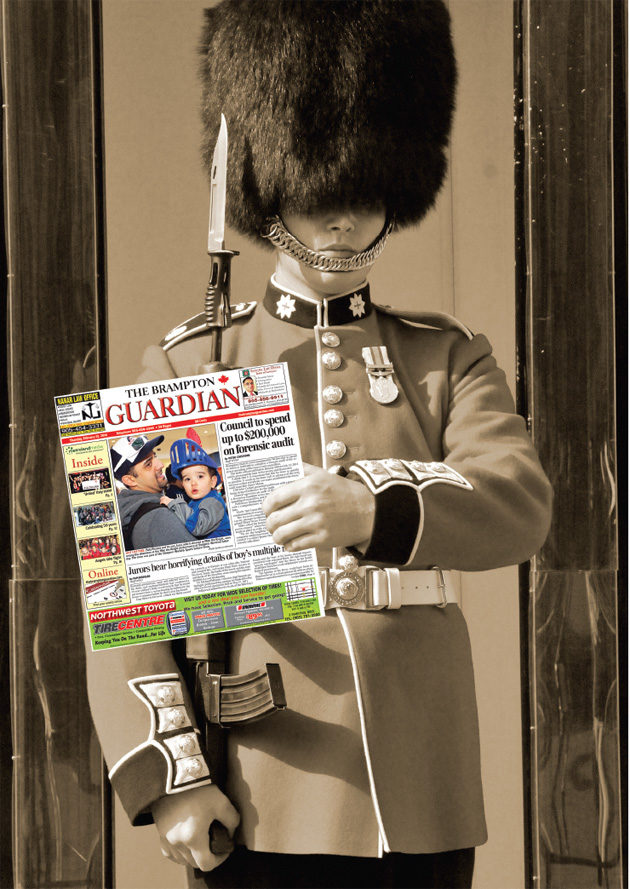The Brampton Guardian’s Uphill Battle
Why one of Canada’s fastest-growing cities may not be getting the coverage it deserves
By Jessica Galang
After working a 12-hour shift on a Friday night in 1983, the Brampton Guardian’s editors and writers head to Ricky Joe’s, their fa- vourite nearby hangout. When they open their menus, they see a picture of themselves from one of the many nights they’ve spent there. These reporters don’t mind putting in the hours to cover their city of 170,000 people, 30 kilometres northwest of Toronto. It’s a time of dinners at Swiss Chalet and staying up late doing lay- outs. “We were all young, ambitious and got along famously,” says former sports reporter Jim Wilson. “It’s hard to replicate that.”
This was the golden era, when newspapers could rely on healthy circulation numbers and advertising revenue, and the Metroland Media-owned Guardian was no exception. Brampton had been growing rapidly since the 1958 creation of Bramalea, a nearby suburban community that became part of the larger city in 1974. At the same time, a steady stream of Italian immigrants was settling in the city. “When we were starting out, there was a lot of space for stories, so you could write really substantial pieces,” former community editor Lindy Oughtred says. Wilson adds, “Newspapers made money, the staff made money and the community got a lot of coverage.”
Fast-forward to today: job cuts and shutdowns are common in the newspaper business, thanks in part to free or near-free access to information. The population of Brampton is now 524,000, about a third of which identifies as South Asian. Once Brampton’s largest ethnic group, Italians are now seventh of 15.
Though the Metroland empire of 114 community newspapers still fares well financially—in 2012, Torstar reported its subsidiary generated $548 million in revenue—critics wonder if this fiscal health, based on aggressive advertising sales, hinders reporters’ ability to write quality editorial. A growing concern is whether the intense focus on the bottom line compromises the Guardian’s ability to reflect Brampton’s burgeoning South Asian community. Add to this volatile mix competition from at least 25 South Asian media outlets, and the paper faces the steep challenge of remaining relevant to its own city.
The free tri-weekly Guardian began as a corporate, tabloid-sized weekly in 1964. Published by development giant Bramalea Limited, it touted the successes of the new Bramalea community. Inland Publishing added the paper to its roster of suburban community publications in 1966. In 1981, Torstar bought Inland and its community newspapers, including the Guardian, and then combined them with its subsidiary Metrospan to create Metroland.
The paper’s office is in a strip mall with a Longo’s grocery store, a sushi restaurant, a Second Cup, a McDonald’s and an all-you-can-eat Chinese buffet. The space theGuardian occupies has an old red-brick facade. The glass door is so difficult to open that a sign reads: “Please press button for assistance if door is too heavy.” Inside, a secretary sits at a mahogany desk in a yellow lobby. Behind a couple of chairs, in a small waiting room, huge windows reveal a parking lot, a courthouse and another plaza. The secretary buzzes guests in, apparently assuming the editorial department is easy to find.
It’s not just the lobby—the entire space, even publisher Dana Robbins’s office, is a sunny yellow. The labyrinth of brown carpet and black cubicles seems impossible for a novice to navigate. I walk into a department at random and ask a woman for directions to editorial. She leads the way through twists and turns until I see seven reporters, tucked away in a corner, working quietly at their desks.
Pam Douglas, who has a police scanner at hers, also has a shooting target peppered with bullet holes, a souvenir from when she tried out a gun years ago while working on a piece about newly issued police firearms. A small woman with dark brown hair and glasses, Douglas is an award-winning journalist who’s passionate about crime reporting. She used to work in georgetown, a com- munity to the west, but there was so little crime there that she was glad to move to Brampton to cover homicides.
Facing Douglas is Ashley goodfellow, a red-headed arts and entertainment reporter. Her cubicle is beside the office of man- aging editor Chris Vernon. The two women chat without raising their voices, because he keeps his door open. Vernon, a 19-year employee of Metroland, sounds like Saul goodman from Breaking Bad. He’s a trooper—in by six, out at five or six every night.
The Guardian office is strangely muted. Even on a production day, reporters rarely move from their desks. Once in a while, a quiet voice does a phoner; once in a while, cars honk in the parking lot. Always, there are keyboards tapping. It’s a stark contrast to the lively newsroom the former Guardian reporters describe. Then again, today’s reporters work amid the stress of an ever-growing city, with fewer staff, in an industry that no longer has a monop- oly on public information. Most news organizations are trying to determine how they can continue to make money. Within the Metroland advertising empire, the Guardian has it somewhat figured out—at a cost.
Open the 72-page edition of the paper from September 13, 2013, and the reason for the Guardian’s continued success becomes obvious. Squished between flyers, coupons and advertisements promising huge furniture savings are eight news stories. The pa- per’s average ad-to-edit ratio is 7:3—but the city is more than three times larger than it was in the Guardian’s heyday, which makes comprehensive coverage that much more difficult. “Because ofthe size of the community, you have twice as much news,” says former sports editor Ken giles. “You can’t get it all in, because you don’t have enough space.” He’s lived in Brampton all his life, and the city even named a recreation centre after him in 1980. He sums up his frustration with the paper today: “You can’t get 100 pounds of potatoes in a 50-pound bag.”
The tug-of-war between editorial and advertising is nothing new. In the past, sales sometimes took precious editorial space at the last minute, and journalists saw stories they might have worked on for days get cut. “I started to get frustrated with the advertising department trying to be pushy,” says Oughtred, who left the Guardian in the late ’80s. “You weren’t doing as much writing as you would’ve liked,” says giles. Toward the end of his career, giles grew tired of hearing sources complain that stories about them didn’t have enough detail. “You get enough angry people at you in a day, and I would say that was a major reason why I was ready to go.”
On the flip side, management needs revenue to keep its papers afloat as advertisers creep onto the web. Major dailies are strug- gling to sell ads, but there’s still demand among advertisers for space in community papers. “Obviously that’s why we’re doing better,” says Jill Davis, a former Guardian reporter and editor who is now editor of Metroland’s Halton region division. “People forget media is business—and it’s big business.”
That side of it is Robbins’s chief concern. In his spacious yellow office, he sits on a comfortable, brown-cloth couch underneath framed caricatures of himself. A front page from The Hamilton Spectator, where he was once publisher, hangs beside the door. One of the stories on that page is about a Spec reporter who was found in contempt of court. The reporter “stood his ground,” says Robbins. “That was a really proud moment for me.”
Robbins chuckles when asked about the struggle for print space. “That’s very much a reporter’s perspective,” he says. “What I always say to reporters is that it’s the ads that pay your salary. It’s less of a struggle than maybe it seems to you, or maybe it seems from the outside. The reality is we have a fine sense of what the costs are and what the pressure points are.” The criticism of the coverage in community papers is nothing he hasn’t heard before. “Could we do a better job if we hired 10, 20, 30 more reporters?” he asks. “Yeah, for a year, and then we’d be out of business—that’s the truth of it.”
As the city around it grew, the Guardian’s masthead shrank. In 1983, there were 14 reporters, editors and photographers. “Metroland became unionized,” says Wilson, “and they cut back on staff almost immediately.” Today, the paper has a staff of 11— not a huge difference, but the city it covers is now at least three times larger. “We had three people in our department,” says Frank Juzenas, a Guardian sports reporter for 28 years, “and it’s now two, so it just makes it tough.”
While the Toronto Star can afford to pursue in-depth investigative pieces about Brampton issues, including “white flight” and Mayor Susan Fennell’s spending scandals,Guardian reporters simply don’t have the time. “We do everything,” says Davis. “At bigger papers they have the luxury of not having to help proofread the pages or load them onto the web.”
Despite Brampton’s growth, some Guardian stories have a small-town feel. At the same time as several reports of Fennell’s misuse of taxpayer money appeared (she allegedly spent $186,000 on luxuries such as a personal driver and airline seat upgrades), the Guardian published a 612-word online piece by Douglas reporting that the mayor was now spearheading changes to councillor spending, and quoted Fennell claiming the Star’s report “lacked context.” It included no critical voices—no voices other than Fennell’s, in fact. The paper did, however, report on and file an access to information request for her expenses.
In September 2013, the Star reported on a Brampton council meeting in which Councillor John Sprovieri criticized a much-delayed $500-million city hall expansion, a sidewalk that may not meet zoning laws and the city’s seeming reluctance to release cost details to the provincial information and privacy commissioner. The headline read: “Brampton city hall project a ‘fiasco,’ says Councillor Sprovieri.” The Guardian’s report—buried on page five under the headline “Council asked some tough questions about sidewalks”—made no mention of the city withholding in- formation. It focused solely on the councillor’s concerns about narrowing the road to extend the sidewalk.
Even when Guardian reporters want to pursue investigative pieces about the city, they can’t always find the necessary time. Back in January 2013, Douglas began working on a series about the way councillors were using discretionary expense accounts, arguably one of the Guardian’s biggest stories of the year. She started to go through spending reports line by line, but was soon bogged down with other work—“I have a lot of beats to cover, and I got sidetracked”—and didn’t have time to resume work on the story until October.
Elaine Moore, a downtown Brampton regional councillor, thinks the lack of resources shows in the paper, and that means the community isn’t engaged in the municipal government the way it should be. “Having a local paper is good,” she says, “but it has to be filled with relevant content.”
Fifty-one percent of Brampton’s population was born outside of Canada, and outlets have sprouted up to satisfy the need for news from back home. The Guardian’s top brass is aware of this phenomenon and publishes, in English, a sister newspaper called South Asian Focus. But former Star deputy managing editor John Miller believes Metroland will eventually have to merge the publications, because a separate paper says “You aren’t really part of the mainstream community—you’re a special-interest group.”
The existence of South Asian Focus may be a symptom of a larger problem, says Moore. Brampton is in danger of becoming a “community of islands”—splintered ethnicities in one city—together but separate, with no incentive to connect. “The Guardian’s challenge is that it has a lot of competition,” Moore says. “Does it focus all resources and energy into one part of the city, or one of the islands?”
But Jagdish Grewal, editor of the Brampton-based Canadian Punjabi Post since 2002, says, “Publications like the Guardian or the Star, they can’t understand the problems of these communities. The kind of coverage we can do is from the grassroots level.” His paper’s boardroom is lacklustre—the walls, like the Guardian’s, are yellow (though stained and scratched) and lined with plaques of recognition from various community organizations. He understands what Moore means when she refers to a “community of islands” and hopes Brampton’s South Asians will mix in, rather than stick to what he calls “ghettos.” Not that he blames anyone: the community is self-sustaining, with Punjabi barbers, Punjabi accountants, Punjabi doctors—name the occupation. “A kid born into a Sikh community could not learn a single word of English,” he says, “and can find a good job and survive.”
Grewal says the government spends millions teaching immi- grants Canadian values, yet South Asians don’t feel the need to participate in or see themselves as part of that established, larger society. Journalists with an understanding of South Asian cultures might help to bridge that gap. “Although I’m running this paper in Punjabi,” Grewal says, “my editorials are about how federal and provincial policies are changing and how this is af- fecting our lives.”
Metroland’s South Asian Focus is obviously challenging the Post for ad dollars, but Grewal wonders about the quality of the coverage it provides. He says the idea thatSouth Asian Focus is an opportunity for Metroland to cash in—rather than an attempt to act as a bridge between mainstream Brampton and its South Asian community—isn’t that far-fetched.
No one is willing to calculate exactly how much cutting editorial has affected the quality of journalism appearing in the Guardian. But there’s evidence Metroland is trying to make some changes— besides appointing Robbins, a sharp, experienced publisher, in 2013, it recently promoted Patricia Lonergan to editor-in-chief of Metroland South, which includes the Guardian, The Mississauga News, the Orangeville Banner and The Caledon Enterprise. A Master of Journalism candidate at Carleton University, she was once managing editor of Metroland Media Ottawa, where she oversaw 11 community papers. Vernon is now regional managing editor of four papers in Metroland South.
No matter who’s on top, there is at least one true-blue believer in the Guardian’s mission. Photographer Bryon Johnson hasn’t been at the paper as long as some of his colleagues—just 14 years. Although he’s aware of the challenges the paper faces, he views them through rose-coloured glasses. “I’m seeing community journalism as the growth industry now,” he says, adding that it’s paying the bills for staff. While he admits there was more space for stories in the past, he says everyone in the print business is trying to figure out how to keep journalism profitable. It just so happens that right now the Guardian is doing a better job than most. “We’re going through an evolution,” he says. “The thing about history is we’re living it right now.”
This piece was published in the Spring 2014 issue of the Ryerson Review of Journalism.
Related Posts
 Friday’s attacks were not the deadliest violence in France since the Second World War
Friday’s attacks were not the deadliest violence in France since the Second World War Mental health: why journalists don’t get help in the workplace
Mental health: why journalists don’t get help in the workplace On the national security beat: Michelle Shephard
On the national security beat: Michelle Shephard How BlackBerry execs bullied journalists and why nobody fought back
How BlackBerry execs bullied journalists and why nobody fought back Office space: the story behind newspaper buildings
Office space: the story behind newspaper buildings Spring 2014: The Brampton Guardian’s Identity Crisis
Spring 2014: The Brampton Guardian’s Identity Crisis
Jessica Galang was the Head of Research for the Spring 2014 issue of Ryerson Review of Journalism.








































